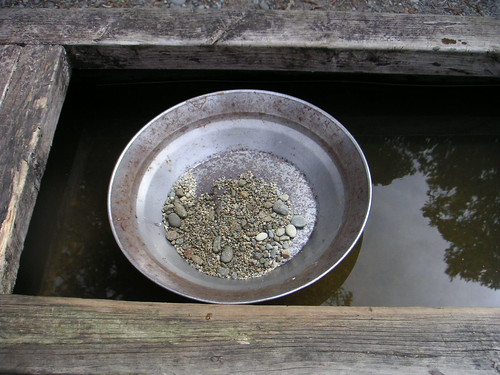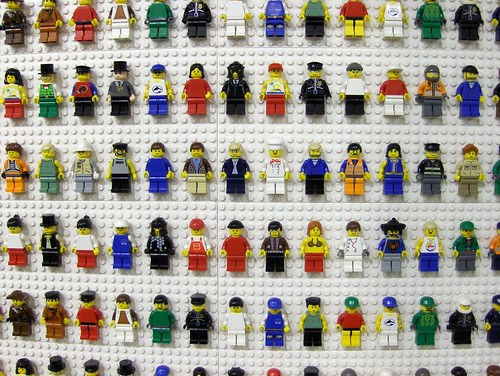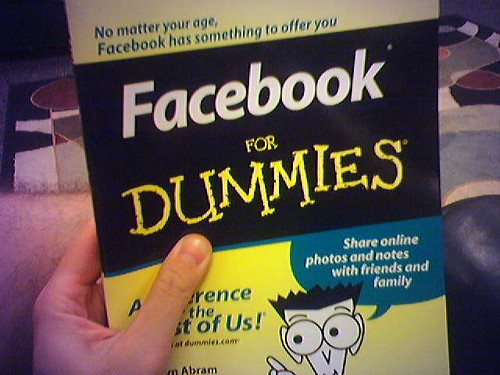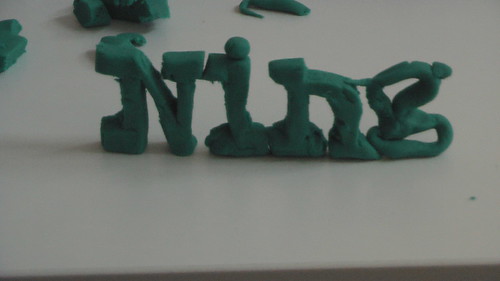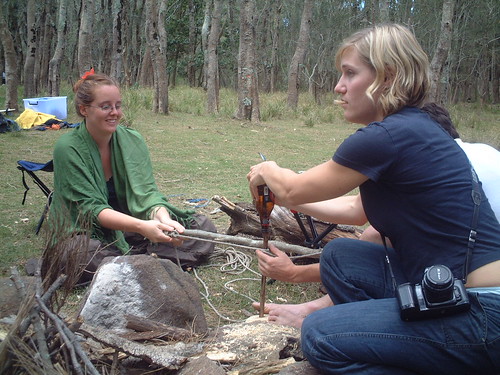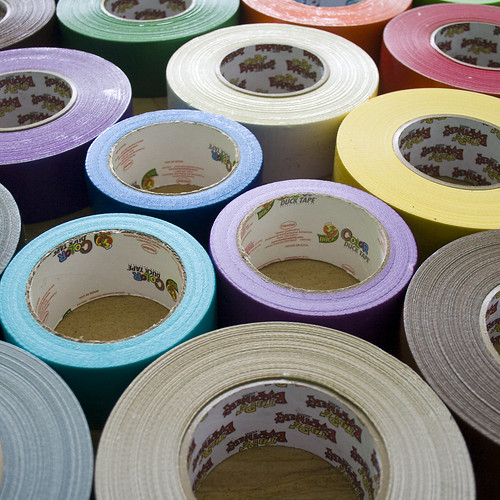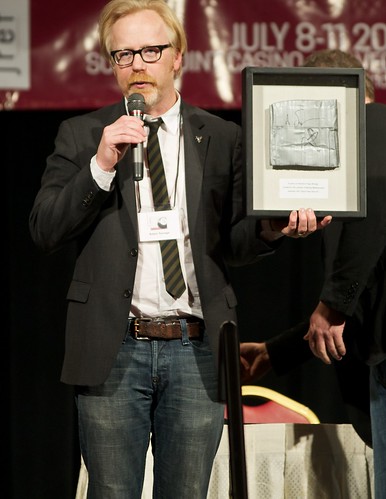 |
| Ivan Walsh's Flickr photostream |
My first tweet was uncomfortable. I didn't like the idea of giving a play-by-play of my daily routines. For one, they aren't that interesting. Secondly, none of my family or friends use Twitter as a social or professional tool, and those are the only people I could imagine being slightly interested any of my tweets.
 |
| bradleyolin's Flickr photostream |
As far as what I was getting out of Twitter...not much. I didn't get some of the lingo being used - a condensed way of sharing information due to the microblogging nature of this tool (messages need to be given in 140 characters or less). I wasn't following anyone I knew, so I wasn't really interested if they were going for coffee or doing errands. I felt alone
in the mine!
I wasn't motivated to check out my Twitter account very often. In fact, I didn't go on Twitter after that summer course ended. It wasn't until this course began that I needed to revive the account and try to put some life into it. So I sent the bird in the cage back down into the mine shaft.
There were a couple of key steps I took that enabled me to understand the potential of this tool on a personal and professional level. The first was a link a classmate provided for a list of Twitter names to follow from the educational field. It was a link similar to Canadian Educators Who Tweet on Listorious, a list I could add my Twitter handle to and in turn the list would automatically set me up as a "follower" to anyone on that list and they were automatically set up as followers on my account. Listorious would do the same with the handles of any newcomers to the list. This was key in growing the list of people I was following, as well as the people following me. My list continued to grow (currently I am following 400 Twitter handles and have 167 following me). The mine shaft was getting productive - and as with any type of information management, periodically one has to review their "workers" to see which ones a producing and which ones need a pink slip.
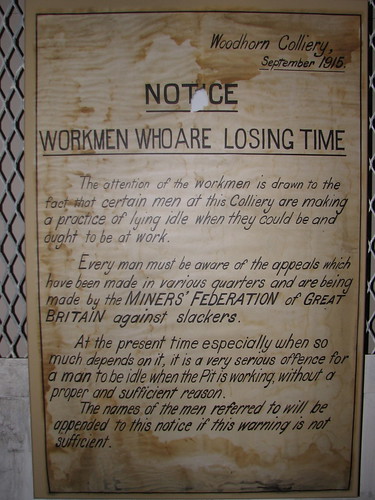 |
| Glen Bowman's flickr photostream |
I had also been following several Twitter handles required by this course. These are great resources in the area of education, technology and web 2.0 tools. The list recommended for this course, to get anyone started in these areas, is as follows (they are the light in the mine shaft):
 |
| Glen Bowman's flickr photostream |
- Will Richardson (@willrich45)
- David Warlick (@dwarlick)
- Joyce Valenza (@joycevalenza)
- Stephen Abram (@sabram)
- Dean Shareski (@shareski)
- Alec Couros (@courosa)
- Ross Todd (@RossJTodd)
- Miguel Guhlin (@mguhlin)
- Steve Hargadon (@shargadon)
- Scott McLeod (@mcleod)
- Mack Male (@mastermaq)
- Judy O'Connell (@heyjudeonline)
- danah boyd (@zephoria)
- Buffy Hamiton/The Unquiet Librarian (@buffyjhamilton)
- Joanne de Groot(@joannedegroot)
 |
| cliff106TM's flickr photostream |
 |
| homard.net's flickr photostream |
It wasn't until I set up TweetDeck that I really got this Twitter thing. (Will Richardson mentions another platform, Nambu, which I have not investigated but at a first glance, does look very worthy of consideration.) TweetDeck brought Twitter to life for me. I have set up columns on this platform which allows me to manage my Twitter lists; to follow groups I have created, both public and private; and to sort and manage the information coming to me from Twitter. I can chose specific groups identified by a hashtag (i.e. #edtech) which is typed somewhere in the tweet so anyone can search for any tweets containing this identifying hashtag (these are easy to create - just put # followed by a group name you want and include it in your tweets for that group). Each list I select to add to TweetDeck then shows up on the TweetDeck dashboard. I can create a list which displays Facebook newsfeeds from my Facebook account. Another list I created was for the Direct Messages to my Twitter account. There is also a list for recommended Twitter handles to follow and finally the list which display the tweets made by the Twitter handles I am following. I could set up as many columns as I wish for particular listings I want to follow. All tweets made under these columns are updated real-time.
Rosaura Ochoa'a Flickr Photostream
Three last things I can do with TweetDeck are searching, composing and syncing. The search columns display searches I have done on TweetDeck and allows me to conduct other searches (i.e. search for specific hastags; search for particular type of information; etc.). I can compose a message to join the conversations on Twitter from TweetDeck so I don't have to leave this site and go to my Twitter account. I can sync TweetDeck with my iPhone (if I had one - I committed to HTC Hero last time I renewed, for reasons I won't go into here). However, I did add Twitter to one of my home screens on my cell phone and I do check the tweets when I am killing time. Anything I like, I simply retweet and then I can easily find it when I am at my computer (I just check out my list of tweets to find anything I have posted).
As I mentioned earlier, managing is a key part of this information mining. I have done this two ways. The first thing I tried to set up as my Twitter account was growing were groups. As I followed a new Twitter handle, I would add it to a particular group, such as "education", "finances", "technology", etc. I have several groups which I have set up, including personal and professional topics.
The second way I manage this information is in TweetDeck, as I mentioned above, by creating lists and columns on my dashboard. Tknoppe gives a good overview to explain the basics and show how to customize your TweetDeck in this Twitter TweetDeck Tutorial.
I can leave TweetDeck running in the background of my computer as I work on other things. Any new tweets or posts will pop up on my screen. I quickly scan them and if it is something I am interested in I look into it - otherwise I let it fade from my screen. For example, tonight I came across a tweet with a link to 101 Ways to Use Twitter on Campus by Online Colleges. It seemed to fit for this week's post, so I explored it. Another tweet which caught my eye was Alternatives to Wallwisher because of my blog from a couple of weeks ago on presentation tools. I doubt I would have found these links in my own searches, but someone was generous enough to share their learning on Twitter. That is really what makes this tool so powerful - so remember to contribute to the community!
As I mentioned earlier, managing is a key part of this information mining. I have done this two ways. The first thing I tried to set up as my Twitter account was growing were groups. As I followed a new Twitter handle, I would add it to a particular group, such as "education", "finances", "technology", etc. I have several groups which I have set up, including personal and professional topics.
The second way I manage this information is in TweetDeck, as I mentioned above, by creating lists and columns on my dashboard. Tknoppe gives a good overview to explain the basics and show how to customize your TweetDeck in this Twitter TweetDeck Tutorial.
I can leave TweetDeck running in the background of my computer as I work on other things. Any new tweets or posts will pop up on my screen. I quickly scan them and if it is something I am interested in I look into it - otherwise I let it fade from my screen. For example, tonight I came across a tweet with a link to 101 Ways to Use Twitter on Campus by Online Colleges. It seemed to fit for this week's post, so I explored it. Another tweet which caught my eye was Alternatives to Wallwisher because of my blog from a couple of weeks ago on presentation tools. I doubt I would have found these links in my own searches, but someone was generous enough to share their learning on Twitter. That is really what makes this tool so powerful - so remember to contribute to the community!
Which leads me to my discussion of what Twitter is and how it works.
For anyone new to Twitter and who wants a good overview to get them started, the Common Craft video Twitter in Plain English is where to start (again, they are just plain entertaining to watch!). As Pam Berger and Sally Trexler (2010) state,
Twitter (http://www.twitter.com/) is a free microblogging tool that can be utilized from a computer, a mobile phone, or a PDA. Postings, which are called "tweets", are limited to 140 characters, including spaces. It is very similar to text messaging, but tweets are published to the Web (p. 172).As Will Richardson (2010) so adeptly points out, "it's that blend of the professional and the personal that makes Twitter such a cool tool on so many levels" (p. 86). This is the reality of Twitter; both pieces really do come in one package.
Personal and Professional Tweeting
Originally I tried to separate personal and professional uses of tweeting, but it really is hard to do. In the many resources I have looked at, the two really do seem to blend together. So, while I will try to address the personal uses first and the professional uses second, it really is hard not to blend here and there.
Using Twitter for personal uses doesn't mean you have to tweet your every move to your followers, as it was originally created for (Richardson, p. 86). You can if that is what you want, but I think that is a superficial use of Twitter. On a deeper level, it can be a tool for just about any aspect of your life. An example that comes to mind was a tweeter who kept appearing on my Twitter account one evening. This person was trying to figure out why something on her computer wasn't working properly. She sent her problem out into her network of Twitter followers - she posted a quick microblog identifying the problem, other gave her suggestions to try, further questions and responses, and finally signing off for the evening not yet having solved the problem but committed to picking it up the next day.
I had never thought of using Twitter in such a way; it was similar to searching blogs and discussion forums for this type of problem solving; however, the responses seemed more immediate. I now understand what Richardson means when he states it "creates a 'network at my fingertips' phenomenon where people ask questions and get answers, link to great blog posts or resources, or share ideas for projects as they go through the day. For many, it's become a running river of conversation and ideas that has cemented their connections to the community..." (p. 86).
William M. Ferriter writes a column for Educational Leadership. In September of 2009 Ferriter wrote a column entitled Taking the Digital Plunge. In this article Ferriter reveals his passion for Twitter and how it can be used to ask questions and share information. In the February 2010 issue he continues this idea in his column titled Why Teacher Should Try Twitter. The one point he makes is he reads through his Twitter feeds regularly - 20 minutes in the morning and again in the afternoon (February 2010, p. 74). I think this is key in "cementing" the connections Richardson mentions. It is like any relationship; you need to nurture it in order for it to thrive.
Ferriter also mentions a few resources worth exploring regarding Twitter. Sheryl Nussbaum-Beach (@snbeach) is a "Teacher Leaders Network colleague and a digital learning expert" (February 2010, p. 73). Her site is 21st Century Collaborative and contains a wealth of information about collaboration. He also mentions Twitter4Teachers, which I had also come across in my own searches. Again, this is another site full of ideas of how to use Twitter in almost any subject area and classroom setting.
Richardson (2010) suggests Twitter Collaboration Stories, a wiki that Nancy White hosts (p. 87). When I checked out this site, these were some of the ideas in a list of many:
Personal uses:
- Coordinate efforts on your cell phone during a power outage;
- A "water-cooler" type of visiting space;
- Collaboration;
- Get advice about purchases;
- Give advice about purchases;
- Locating original sources of information (quotes, books, movies, etc.)
- Technical support;
- Gathering consensus;
- News updates;
- Storytelling;
- To remember ideas you come up with throughout the day.
- Searching for job candidates;
- To get feedback throughout a conference;
- Invite people to collaborate;
- Request suggestions;
- Extend the boundaries of the classroom;
- Dissemination of publications and materials;
- Live Real time databases;
- Global presence and participation in workshops.
- To start conversations
- To recommend books and online resources
- To track favorite authors
- To gain access to a greater pool of opinion
- To post helpful URLs
- To ask advice of experts
- To send reminders
- To share information from conferences
- To promote activities and events
 |
| Kevin Dooley's Flickr Photostream |
- Class chatter
- Classroom community
- Get a sense of the world
- Track a word
- Track a conference
- Instant feedback
- Follow a professional
- Follow a famous person
- Grammar
- Rule Based Writing
- Maximizing the Teachable Moment
- PublicNotePad
- Writing Assignments
I recently attended a workshop which used microblogging throughout the session. We used TodaysMeet for this networking. Richardson suggests Edmodo as a secure social networking site to use in classroom settings. It was the first time I had experienced this and I absolutely loved it. Not everyone at my table shared my affections. Some said they found it distracting. I agree; sometimes I missed something the presenter was saying because I was engaged with something happening on the microblog, but my learning was exponential from this session. I learned many things from the presenter, but my true learning came from the audience. People would tweet questions about things in the presentation they didn't understand, and a wave of responses and links would ensue. I came away with new knowledge and links to resources that the participants in the audience shared.
As a side note, I used Microsoft OneNote to organize the information as it came in on TodaysMeet, so I left at the end of the day with a new section in my Web 2.0 notebook (I have made this notebook public), Digitales, which I created pages in to display the content of links from the day, the notes I had typed during the presentation, and clips of web pages and other pieces of information I gathered. At the end, I was also able to export the transcript from the microblog to my OneNote notebook giving me a complete record of the day. I then synced this with my online Evernote account, and the information is now available wherever I go, whether I have online access or my laptop for off-line access.
 |
| Michael Poley's Flickr Photostream |
The lists are extensive for both personal and professional uses. If you want to search for information and/or groups on Twitter, the Twitter Search is a good place to start.
Richardson also mentions InnerTwitter and this site makes sense, especially in light of a CBC documentary I recently viewed, Are We Digital Dummies? I will leave you to explore both of these and see what connections you make. I pulled the birdcage back up from the mine shaft, and everyone is still breathing!
Tweet! Tweet!
Resources
Bellanca, J., & Brandt, R. (2010). 21st century skills: Rethinking how students learn. Bloomington, IN: Solution Tree.
Berger, P., & Trexler, S. (2010). Choosing web 2.0 tools for learning and teaching in a digital world. Santa Barbara, CA: Libraries Unlimited.
Ferriter, W. (2009). Taking the digital plunge. Educational Leadership, 67(1), 85-86.
Ferriter, W. (2010). Why teacher should try twitter. Educational Leadership, 67(5), 73-74.
Kist, W. (2010). The socially networked classroom: Teaching in the new media age. Thousand Oaks, CA: Corwin.
Richardson, W. (2010). Blogs, wikis, podcasts and other powerful web tools for classrooms. Thousand Oaks, CA: Corwin.

